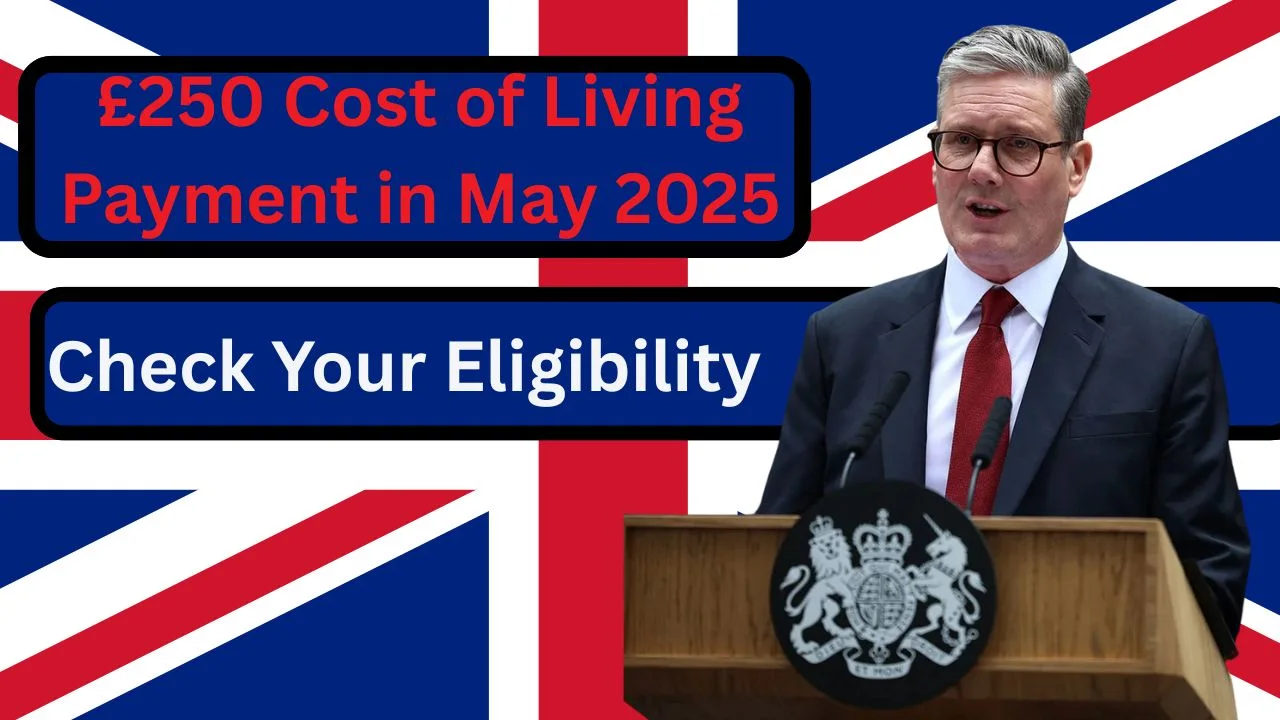As the cost of living continues to challenge UK households in 2025, the government has announced a £250 one-off Cost of Living Payment set for distribution in May 2025. This initiative, funded through the extended Household Support Fund (HSF), aims to provide financial relief to low-income families, pensioners, and individuals facing economic hardship. With inflation, rising energy bills, and increasing food prices putting pressure on budgets, this payment offers a lifeline for those struggling to cover essentials. This article explores the eligibility criteria, payment process, and broader context of the £250 Cost of Living Payment, helping UK residents understand who qualifies and how to claim it.
Background on the Household Support Fund
The Household Support Fund was launched in 2021 to address economic challenges stemming from the COVID-19 pandemic and subsequent global energy crises. Extended through March 2026 with an additional £742 million, the HSF allows local councils to distribute financial aid tailored to community needs. The £250 Cost of Living Payment is a key component of this fund, designed to assist with essential expenses like food, utilities, and housing. Unlike previous universal support schemes, this payment targets vulnerable groups, ensuring resources reach those most in need.
The fund’s flexibility means eligibility and distribution methods vary by local council, but the government has set national guidelines to ensure fairness. This payment follows earlier cost-of-living support, such as the £301, £300, and £299 payments issued between 2023 and 2024, which supported millions of benefit recipients. The May 2025 payment continues this commitment, addressing ongoing financial pressures despite moderating inflation.
Eligibility Criteria for the £250 Payment
Eligibility for the £250 Cost of Living Payment is primarily based on receiving certain means-tested benefits during the qualifying period, typically from 15 January to 28 February 2025. The Department for Work and Pensions (DWP) and HM Revenue and Customs (HMRC) have outlined clear criteria to determine who qualifies. Below are the key eligibility pathways:
1. Means-Tested Benefit Recipients
Households receiving the following benefits during the qualifying period are automatically eligible:
-
Universal Credit: You must have an award period including at least one day between 15 January and 28 February 2025.
-
Income Support
-
Pension Credit: Particularly important for pensioners, as it also unlocks additional support like the Winter Fuel Payment.
-
Income-based Jobseeker’s Allowance (JSA)
-
Income-related Employment and Support Allowance (ESA)
-
Child Tax Credit or Working Tax Credit: Your entitlement must be at least £26 for the tax year.
If your benefit is reduced to £0 due to earnings or other deductions (e.g., rent payments or debt repayments), you may still qualify if you received a hardship payment or if deductions were for reasons other than a sanction. However, if your benefit is reduced to £0 due to a sanction for failing to meet claimant commitments, you are not eligible.
2. Pensioners
Pensioners receiving Pension Credit during the qualifying period automatically qualify. Those over State Pension age (born before 25 September 1957) who are not yet on Pension Credit are encouraged to apply, as it could unlock the £250 payment and other benefits like the Winter Fuel Payment (£250–£600). The DWP estimates that around 8 million households, including many pensioners, will qualify through means-tested benefits.
3. Disability Benefit Recipients
Individuals receiving disability-related benefits, such as Personal Independence Payment (PIP), Attendance Allowance, or Disability Living Allowance (DLA), may qualify, but eligibility often depends on local council discretion. Some councils require proof of low income or financial hardship, as disability benefits alone do not guarantee automatic eligibility. Those also receiving a means-tested benefit are more likely to qualify automatically.
4. Low-Income Households Not on Benefits
Households not receiving benefits but facing financial hardship may still qualify through local council discretionary schemes. Common criteria include:
-
Household income below a council-specific threshold (e.g., £2,000 in savings in some areas).
-
High monthly expenses, such as rent, utilities, or childcare.
-
Recent financial changes due to job loss, illness, or emergencies.
These households must apply manually through their local council, providing documents like proof of income, utility bills, or bank statements.
Exclusions
You are not eligible if:
-
Your tax credit entitlement is below £26 for the tax year.
-
Your benefit was reduced to £0 due to a sanction.
-
You receive only contribution-based JSA or ESA without an income-related component.
Households receiving multiple qualifying benefits will receive only one £250 payment per claim, not per person.
Payment Distribution Process
The £250 payment is designed to be straightforward, with most recipients receiving it automatically. Here’s how it works:
Automatic Payments
For those on qualifying benefits, the payment is deposited directly into the bank account used for benefit payments. The DWP payments will appear with the reference “DWP COL” followed by your National Insurance number, while HMRC payments (e.g., for tax credits) will show as “HMRC COLP.” Payments are scheduled between 6 May and 22 May 2025, though dates may vary slightly to balance system load. No application is needed for automatic payments, but ensure your bank details are up to date with DWP or HMRC to avoid delays.
Manual Applications
Households not on benefits but meeting council-specific hardship criteria must apply through their local authority. The process typically involves:
-
Check Eligibility: Use the GOV.UK “Find Your Local Council” tool to locate your council’s HSF page.
-
Gather Documents: Prepare proof of identity, income, savings, and expenses (e.g., payslips, utility bills, bank statements).
-
Submit Application: Complete an online or paper form, following council instructions.
-
Wait for Processing: Applications take 2–6 weeks, depending on demand. Some councils may issue vouchers instead of cash.
Applications typically open in March 2025, and early submission is recommended as funds are limited.
Payment Timeline
-
Automatic Payments: 6 May to 22 May 2025.
-
Manual Applications: Processed within 2–6 weeks after submission, with payments completed by late May or early June 2025.
If you believe you’re eligible but haven’t received the payment by 1 June 2025, check your eligibility on the GOV.UK Cost of Living Payment portal or contact DWP/HMRC.
Broader Support Programs
The £250 payment is part of a wider safety net. Other programs include:
-
Winter Fuel Payment: £250–£600 for pensioners to cover heating costs, automatically issued to those born before 25 September 1957.
-
Cold Weather Payment: £25 per 7-day period of freezing temperatures (November–March).
-
Warm Home Discount: £150 off electricity bills for eligible households.
-
Council Tax Reduction: Means-tested reductions for low-income households.
These programs complement the £250 payment, helping households manage winter expenses. Check the GOV.UK Cost of Living Hub for details.
Challenges and Considerations
Local Variations
The HSF’s council-led approach ensures tailored support but creates inconsistencies. Some councils offer higher payments or additional aid (e.g., food vouchers), while others have stricter criteria. Check your council’s HSF page for specifics.
Scams
Beware of scams requesting bank details or fees. Official communications come from GOV.UK or DWP/HMRC, never via unsolicited texts or emails. Verify suspicious contacts using official numbers.
Financial Planning
The £250 payment is non-taxable and does not affect other benefits, but saving it could impact means-tested benefits if your savings exceed thresholds (e.g., £6,000 for Universal Credit). Prioritize essentials like energy bills or debt repayment.
Real-Life Impact
For many, the payment offers critical relief. Sarah, a 43-year-old single mother from Cardiff, said, “Last winter’s heating bills were brutal. This £250 will help me stock up on groceries and keep the lights on.” Similarly, James, a 78-year-old pensioner from Norwich, appreciated the automatic process: “I’m not tech-savvy, so knowing it’ll just arrive in my account is a huge relief.” These stories highlight the payment’s role in easing financial strain.
Criticisms and Limitations
While welcomed, the £250 payment has critics. Community organizations, like Marcus Chen of Community Assistance Network, argue it’s a “temporary fix” for deeper issues like housing costs and debt. Some opposition parties call for broader support, especially for working families just above benefit thresholds. The one-off nature and council variations also mean some eligible households may miss out if funds run dry.
Looking Forward
The £250 Cost of Living Payment in May 2025 is a vital support measure for UK households facing economic challenges. Targeting low-income families, pensioners, and some disability benefit recipients, it offers relief for essentials like food and energy. Automatic payments streamline the process for benefit recipients, while manual applications ensure broader access for those in hardship. Combined with other programs like the Winter Fuel Payment, the HSF creates a safety net for vulnerable groups. However, local variations and limited funds underscore the need for early action. Check your eligibility on GOV.UK, update your details, and apply promptly if required. While not a complete solution, this payment is a step toward easing financial pressures in 2025.

